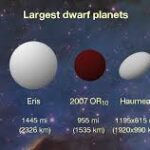For centuries, humans have gazed at the night sky, wondering if we are alone in the universe. That curiosity has driven incredible advancements in astronomy, one of the most exciting being the discovery of exoplanets that orbit stars beyond our solar system. These distant worlds have opened a new chapter in the search for life and a deeper understanding of how planets form and evolve. In this article, we’ll explore what exoplanets are, how they are discovered, the different types found, and what they might tell us about the universe.
What Are Exoplanets?
Unlike the planets orbiting our Sun, exoplanets orbit other stars in our galaxy. Some of them resemble Earth, while others are much larger, stranger, or more extreme in temperature, size, or composition.
The first confirmed discovery of an exoplanet came in 1992, and since then, astronomers have identified over 5,500 confirmed exoplanets, with thousands more candidates awaiting confirmation. These discoveries have completely transformed our understanding of the cosmos.
How Are Exoplanets Discovered?
Detecting exoplanets is not easy; they’re usually hidden in the glare of their parent stars. However, astronomers have developed several clever techniques to find them:
1. Transit Method
This is the most common technique. It involves observing a star’s brightness over time. If a planet passes in front of the star (known as a “transit”), it causes a slight, regular dimming. NASA’s Kepler Space Telescope used this method to discover thousands of exoplanets.
2. Radial Velocity (Doppler) Method
This wobble can be detected by analyzing shifts in the star’s spectral lines due to the Doppler effect.
3. Direct Imaging
Though challenging, it is sometimes possible to capture actual images of exoplanets by blocking the light of the star. This method works best for large planets orbiting far from their stars.
4. Gravitational Microlensing
Occasionally, a massive object (like a star with a planet) will pass in front of another star and magnify its light. This technique has led to the discovery of exoplanets that are otherwise difficult to detect.
Types of Exoplanets
Exoplanets come in many shapes and sizes. Some are scorching hot gas giants; others are icy, rocky worlds.
1. Hot Jupiters
Their surface temperatures can exceed 1,000°C. Examples include 51 Pegasi b, the first exoplanet discovered around a Sun-like star.
2. Super-Earths
These planets are more massive than Earth but lighter than ice giants like Neptune. They could be rocky or have thick atmospheres and are among the best candidates for habitability.
3. Mini-Neptunes
Smaller than Neptune but larger than Earth, these planets often have thick hydrogen-helium atmospheres. They might have rocky or icy cores.
4. Earth-like Planets
These are rocky planets in the “habitable zone,” the region around a star where temperatures might allow liquid water to exist. Examples include Kepler-452b and TRAPPIST-1e.
5. Rogue Planets
Some exoplanets don’t orbit a star at all. These free-floating planets likely formed around a star but were ejected by gravitational forces.
The Search for Life
One of the most exciting aspects of exoplanet research is the search for extraterrestrial life.
- Rocky and Earth-sized
- Located in the habitable zone
- Possessing an atmosphere with potential biosignatures (e.g., oxygen, methane)
In 2021, the James Webb Space Telescope (JWST) launched, equipped with tools to analyze the atmospheres of exoplanets in detail. Its infrared capabilities allow it to detect chemical fingerprints in exoplanet atmospheres, bringing us closer to identifying planets that could host life.
Notable Exoplanet Discoveries
Here are a few exoplanets that have captured the attention of scientists and the public alike:
1. Kepler-186f
It lies about 500 light-years away.
2. TRAPPIST-1 System
This star system contains seven Earth-sized planets, three of which lie in the habitable zone. It’s located about 40 light-years from Earth and has become a top target in the search for alien life.
3. Proxima Centauri b
At just 4.24 light-years away, it’s our nearest potentially habitable exoplanet.
4. HD 209458 b (“Osiris”)
This was the first exoplanet observed to transit its star and also the first where an atmosphere was detected.
What Do Exoplanets Tell Us?
Exoplanets offer more than just a list of strange and wonderful worlds; they help us answer fundamental questions:
- How common are planets like Earth?
- How do planetary systems form and evolve?
- Is our solar system unique or typical?
- Could life exist elsewhere?
By studying the variety of exoplanets and their stars, we gain insights into the diversity of planetary systems, the conditions that lead to habitability, and even the possible fate of our planet.
The Future of Exoplanet Research
The field of exoplanet science is still in its infancy. In the coming decades, new missions like the European Space Agency’s PLATO, NASA’s Roman Space Telescope, and future ground-based observatories like the Extremely Large Telescope (ELT) will further expand our catalog of exoplanets and deepen our understanding of their atmospheres and potential for life.
Artificial intelligence and machine learning are also playing a growing role, helping astronomers sift through massive data sets to identify planet candidates faster and more accurately.
Conclusion
The discovery of exoplanets has fundamentally changed the way we see the universe. No longer do we wonder if planets exist around other stars. We know they do, in staggering numbers and stunning diversity. While Earth remains our only known haven for life, the ongoing study of exoplanets brings us closer to answering one of humanity’s most profound questions: Are we alone in the cosmos?
As technology advances and our gaze reaches farther into space, exoplanets will continue to be at the heart of cosmic exploration, inviting us to dream, to discover, and perhaps one day, to travel beyond our solar system.



